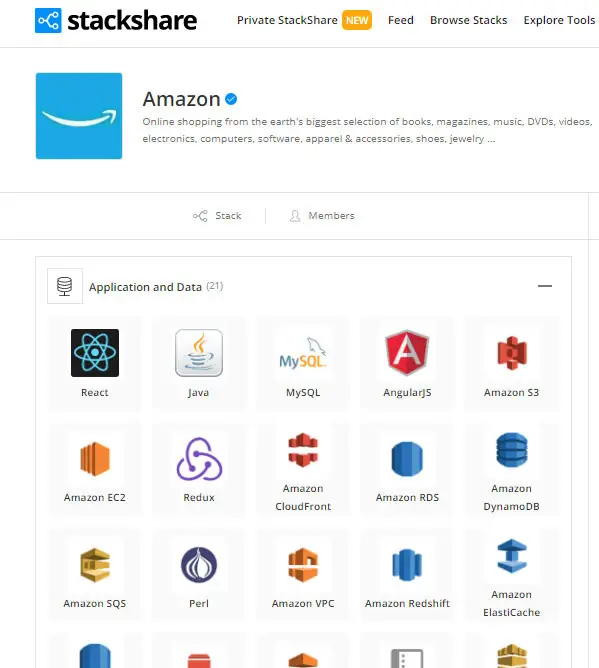Without any doubt, Amazon has proven itself as the leading and most trustworthy eCommerce platform on the planet. With tons of sophisticated features and millions of continuously offered products, this platform is running a highly advanced and cutting-edge platform and technology stack.
The tremendous success of Amazon made many of us curious about what content management systems and technologies Amazon use to provide their services. Basically, to inspire by their experience or to build a similar success story.
It’s fairly difficult to tell what CMS, technologies, and databases Amazon web stores utilize on their websites. However, we tend to say that Amazon runs its own, customized, and highly advanced content management system and eCommerce platform.
We try to discover what CMS and technologies that Amazon uses to bring us this great shopping experience. We also list some suggestions for those who look forward to building similar online shops.
1. Does Amazon Use CMS?
Content management systems are applications for managing the creation and modification of digital content. There are various types of CMS platforms, each of which has specific purposes and deals with particular content types.
In this context, Amazon is considered an eCommerce application that is dedicated to buying and selling products online.
Like any other eCommerce system, Amazon offers an online shopping solution that enables sellers to manage their products and sell them online through multiple Amazon websites.
That being said, does Amazon use a CMS? Yes, indeed!
Amazon does use a sophisticated content management system to be able to fulfill the highest levels of product management and accessibility.
The whole product management process takes place using interactive interfaces. These user-friendly interfaces enable the sellers to easily add products, fill in their details, upload photos, and set pricing info.
Every single operation is performed totally online without the need for any technical help or coding skills. This wouldn’t happen without a content management system.
2. Which CMS Is Used By Amazon?
There are various ways to detect the content management system used by a website. Primarily by discovering indicators in the content or structure of the delivered web pages.
Some CMS detection methods are done manually by inspecting the website in the browser and analyzing hidden features of the webpage, such as the page source or link structure.
Other automatic tools are also available to do CMS detection automatically on a website by using a bunch of predefined rules.
Nevertheless, the success rate of all these methods relies on how far the used CMS was customized from its default installation. This becomes much more tricky if the website development team has applied techniques to hide the platform details from being publicly detected by visitors, usually for security reasons.
For this article, we used 5 automatic tools to detect which platform the amazon.com website is built in, and here are the results:
| CMS Detector | Results for www.amazon.com |
|---|---|
What CMS |  |
CMS Detect | |
Site Analyzer |  |
Online Web Tool |  |
| Web Data Stats |  |
Looking into the results, no tool was able to detect the content management system behind amazon’s website.
This leads to one of the following “unconfirmed” assumptions:
Amazon uses a third-party eCommerce platform that is extensively customized so it can’t be easily detected.
OR
Amazon uses its own “custom-built” content management system.
Based on our experience in web development, we believe to a large extent that Amazon depends on its in-house developed system to run its stores.
Nonetheless, without a confirmation or indication by an authoritative resource from the company itself, no one can determine what content management system is running on Amazon’s websites.
3. What Technologies and Databases Does Amazon Use?
Following the same previous discussion, it will be also difficult to reveal the technology stack that Amazon’s online stores use to run their eCommerce business.
Considering the complexity of their business, Amazon should be utilizing a complex development platform that combines several programming languages, techniques, and libraries.
In terms of technology detection tools, it’s practically not reliable to use automatic detectors to reveal the underlying development environment of Amazon websites. Since the only possible way to detect the website technologies is to inspect the front-end side of the website. This way, only client-side languages such as HTML, CSS, and JavaScript will be presented.
Accordingly, it will be extremely difficult to unveil which programming languages or databases Amazon websites are using in their back-end frameworks.
Nevertheless, here is an example of what technology stack is used by amazon.com as inspected by https://builtwith.com/ (to browse the full list please refer to this link).

Additionally, StackShare is a community-driven platform that reports software tools and who’s using them. The platform lists some technologies that Amazon uses in its stack (their claim). The list shows multiple items such as React, Java, MySQL, AngularJS, and many others.
Nevertheless, although StackShare might give some details about the underlying technologies, as a community-based environment, StackShare can’t be treated as a trusted source of information.

4. Which CMS Platform Is Similar to Amazon?
As mentioned earlier, Amazon websites most likely use their custom-developed content management system. To the best of our knowledge, there is no eCommerce platform identical to what Amazon does on its web store.
To build a similar eCommerce platform, the best (but very expensive) option would be to develop your own eCommerce solution. However, an alternative solution might be to try to mimic Amazon’s features using an existing eCommerce system.
To do so, you need to use one of the advanced and highly customizable eCommerce platforms and modify it to serve your needs.
Here are some examples of potential content management systems that might do a similar job to the Amazon web stores:
WooCommerce
WooCommerce is one of the world’s most popular e-commerce platforms. It isn’t technically a standalone CMS platform. Instead, it runs as a plugin on WordPress. WooCommerce is designed for online merchants of different sizes. According to multiple sources, this solution powers over 4 million websites and more than 26% of all online stores.

Shopify
Shopify is an e-commerce platform to build stores both online and offline. It’s a cloud-based software that operates on monthly subscription plans. It offers a suite of services such as payments, marketing, shipping, …

BigCommerce
BigCommerce is an e-commerce platform that utilizes software as a service (SaaS) for retailers. It includes online store management services for up to medium businesses. BigCommerce helps businesses manage online and mobile stores, as well as handle payments and currency conversions.

5. Conclusion
Just like any giant tech company, Amazon has multiple development teams with various technical and professional expertise. Each team uses its own technology stack and is responsible for specific services of the online shop.
In this article, we tried to explore the content management system and technologies that Amazon’s websites employ in their development environment.
To sum up:
- It’s difficult to detect which framework or CMS Amazon websites run on.
- We believe that Amazon uses its own custom-built content management system.
- Amazon has a complex development platform that utilizes several programming languages and techniques.
- It’s difficult to unveil which programming language or databases Amazon websites are using in their back-end platforms.

